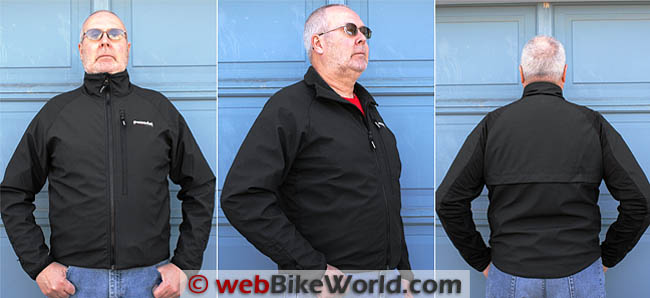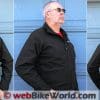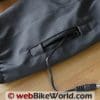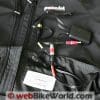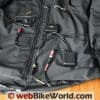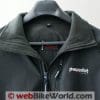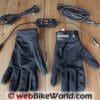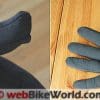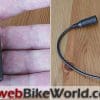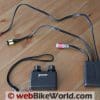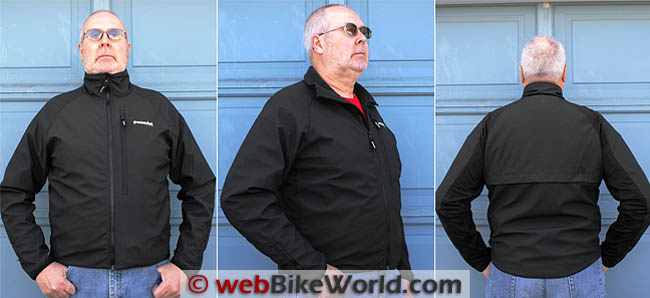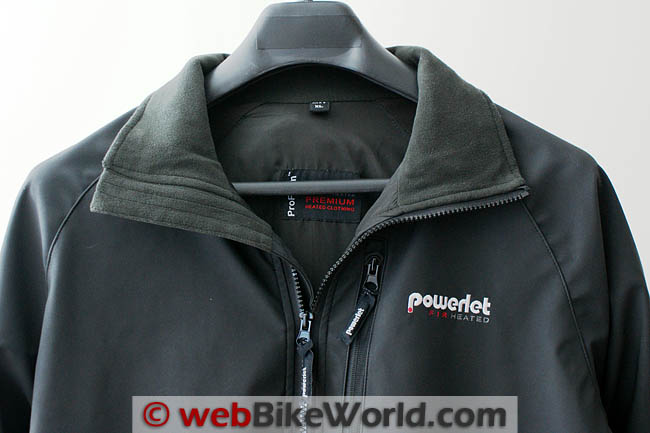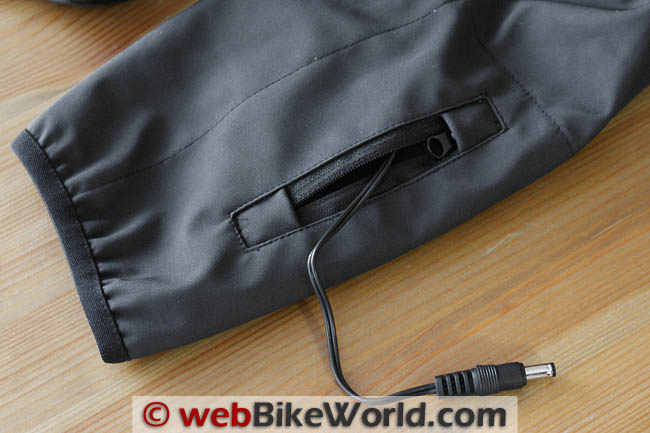The new Powerlet RapidFIRe heated clothing line represents an innovative and completely effective solution to an age-old problem: how to keep warm, comfortable and safe while doing what we all love — riding on two wheels.
I have never worn anything that works as well as the RapidFIRe heated clothing to keep me warm and alert.
If the Proform heated jacket liner and RapidFIRe heated glove liners represent what is forthcoming under this new Powerlet line of heated clothing, I’ll take more of it in a heartbeat.
Powerlet is releasing a leading-edge line of heated garments and while the products are just coming to market, webBikeWorld was offered the opportunity to be the first to evaluate some of the pieces from this exciting new line.
So the rush was on to get the kit in hand and evaluated before heat and humidity replaced cold and black ice!
As we are still experiencing cooler temperatures up here in the not-so-white North, the Editor figured that I would have two or three weeks of ideal test weather. Besides, he knows I can’t resist new stuff that is technology driven…
Powerlet and its parent, Coliant, have long been involved in marketing products for wheeled enthusiasts and they are undoubtedly one of the biggest players in the motorcycle market.
For many, the Powerlet name is synonymous with electrical products geared for motorcycle use.
Thus, moving or expanding into the heated garment segment can be understood; their experience and reputation for quality cannot be dismissed.
After all, Powerlet proudly points out that their products are “designed by riders for riders”.
Another factor that probably plays into the Powerlet strategy is the fact that so many of us enthusiasts among the “aging population” tend to look for products (accessories if you will) that increase the comfort zone and by extension, prolong the riding season.
Needless to say, my interest level was very high as I wanted to discover just how well — or not — the FIR (Far Infrared) heating technology used by Powerlet in the rapidFIRe heated clothing works.
So with a Powerlet rapidFIRe Proform jacket liner, a wireless dual heat controller and a rapidFIRe glove liner kit with its own digital controller in hand, it was time to get started.
Powerlet rapidFIRe Technology Overview
The Powerlet rapidFIRe products feature Carbon nanocore (CNC) heating that uses Far Infrared or FIR to provide almost instantaneous warmth that is deep and soothing.
In the absence of technical and specification information for these coming-to-market products, some basic information regarding carbon nanocore and far infrared is provided for information purposes.
Based on the Carbon nanocore term used, I suspect that carbon nanotubes, which are an allotrope, or form of carbon, are used or some variation thereof.
Carbon nanotubes are very thin, very strong and very suitable for use in thermal heating applications; think of them as nanowires, if you will.
The use of infrared for heating purposes is not new, but to the best of my knowledge, this is the first widespread implementation for the wheeled enthusiast market.
Far Infrared is a segment of the electromagnetic or EM spectrum that occurs beyond the nominal edge of visible red light.
Like much of the spectrum, which we use and exploit, this band of light is not visible to the human eye, although it can be seen by special cameras that translate infrared into visible colours.
What makes infrared such a viable medium to use is the fact that we can actually feel this type of light as heat.
The sun is an important source of infrared energy that we absorb every day and closer to home our own tissue normally produces infrared energy for warmth and tissue repair.
As a form of energy, infrared or radiant heat does not have to heat the surrounding air but is able to heat objects directly. Energy released from infrared heat penetrates the skin and insulating layers deeper, producing a heating effect from the inside out rather than from the outside in like more traditional heating sources.
This deep heating and radiation can bring multiple benefits; raising body temperatures especially at the surface, increased surface blood flow and improvements in overall circulation.
As externally generated and human infrared radiations are or can be closely “tuned”, it is possible for body tissue to absorb close to 93 percent of the infrared waves that reach the skin, making this a very efficient and very effective medium.
So in very general terms, the carbon nanocore technology is the backbone or carrier while infrared is the medium or source of the radiated heating energy.
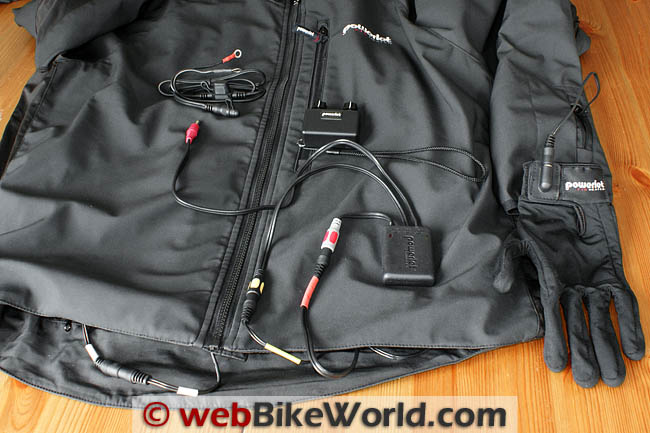
Powerlet RapidFIRe Proform Heated Jacket Liner (PHG-101)
When the Editor asked me sizing information, I was a little leery, having been down this road many times before and typically with some disappointment…which is why I tend, at 6 ft. 2 in. and around 220 lbs., to oversize myself — just to be on the safe side.
But the Powerlet sizing chart seemed very much in line with some other manufacturing charts that I have come to trust explicitly (like Firstgear).
So I took a chance and went with XL for the jacket liner and the L/XL size for the glove liners, which I knew were made of stretch material anyway.
Immediately upon receiving the goodies from the Editor, I anxiously tried on the jacket liner, wearing only a light short-sleeved and a very thin long-sleeved cotton T-shirt combination. This is my normal next to body layering, at least until its much warmer outside.
The liner is a perfect fit for a heated garment; slightly snug in the body with comfortable finished sleeves (reduced bulk) that are, best of all, long enough.
You know that feeling when something just feels and fits right? Well, I got it. Bonus marks were assigned on the spot.
The outer shell is made of polyester (labeled as “All Coated Polyester”) and the proofing coating provides good resistance to moisture — helpful when being worn as a casual outer garment.
The inner liner is also polyester with elasticity provided by the material and Spandex, particularly for the integrated stretch panels.
ProForm stretch panels are common to all Powerlet heated garments and they are one of the biggest factors in getting a comfortable snug fit, so important for maximizing heat transfer.
On the jacket liner the tapered inserts start just behind the shoulder and run the full length of the sleeves.
A full-length one-way watertight zipper runs right up to the top of the Polartec fleece collar, with a small pad of the material situated so as to cover the top of the zipper and eliminating the irritation point caused by the zipper tab, something that bugs the heck out of me.
An extended back provides a snug fit over the lower portion of the back and seat, again important in providing a good snug fit between the heated garment and the body. Weight is on par with competitive products.
Internal wiring leads, what there is of them, are very thin and pliable as are the heating pads.
Outside of the interconnection wiring bundle in the lower left front pouch, the internal components are hard to see and totally unobtrusive when the garment is worn.
Opening up the small zipper to access the left side pouch reveals far more than was expected. It is crowded in there, but the circuit and use labels on the lower inside front of the liner make sense of it all.
The bundle actually consists of a small sealed module that is both the wireless receiver for the palm-sized controller and the physical interface for the electrical leads (more detailed information is provided in the Installation and Configuration section below).
A matching pocket is found on the right side housing a single “White” label connection.
When joined, the jacket liner has its full 105 Watt output potential and when disconnected output is reduced to a maximum of 60 Watts. This allows continued heat coverage where demand is not likely to be high or when power limitations exist.
Coaxial lead glove connections are built-in and housed inside small lower sleeve pockets behind small watertight zippers.
The front left chest area features a vertical zipper providing access to a huge inner pocket.
Two smaller pockets or pouches, one with an elastic cuff at the top, are stitched onto the inner wall of the larger pocket and both are just right for holding mobile phones or other portable devices.
Mid-way down the back of the garment is a full width horizontal zipped pouch that functions as the stuff sack for the garment – right-sized for folding up and storing the liner and controller during transport or when on the shelf.


Powerlet Dual Wireless Temperature Controller (PHG-322)
I must say that getting a wireless controller was icing on some very tasty cake. Between using a lot of Bluetooth devices and helmet communications systems and the wireless control feature of theDispatch 1 power management system (review), I’m getting a bit spoiled.
The palm-sized Powerlet dual temperature remote control, being wireless, can be carried or mounted almost anywhere. This remote control convenience means the small waterproof controller module can stay inside the storage pouch of the garment.
Included in the controller kit is the fully detachable controller module with its three leads, the wireless and very portable remote control unit with its two rotary controls, and a 15A fused harness for direct connection to the battery.
Powerlet products are known for their versatility and this controller does not disappoint. By using the industry standard 2.5 mm coax connectors, it is compatible with most DC heated products.
As long as the right connections can be made between other heated garments and the controller module, it should work.
Electrically, the wireless controller system handles 15 Amps at 13 Volts, with an internal reset function addressing overloads and shorts. A voltage range from seven (7) to 24 Volts is supported.
To address safety and consumption issues, a temperature controller should be used with all garment applications.
One can run a garment directly off the power lead but that then precludes “control” and unless in extremely cold conditions, this is not typically a wise option.
Using any controller, wired or wireless, provides modulation and therefore control of the power drawn from the motorcycle, an important factor where excess electrical capacity is not abundant, as on many smaller machines.
Being able to configure the jacket liner for 105 or 60 Watts is another very useful feature.
Performance-wise, once the small remote control is synced to the receiver module and all necessary connections made (described in the Installation and Configuration section below) the system is ready to be used.
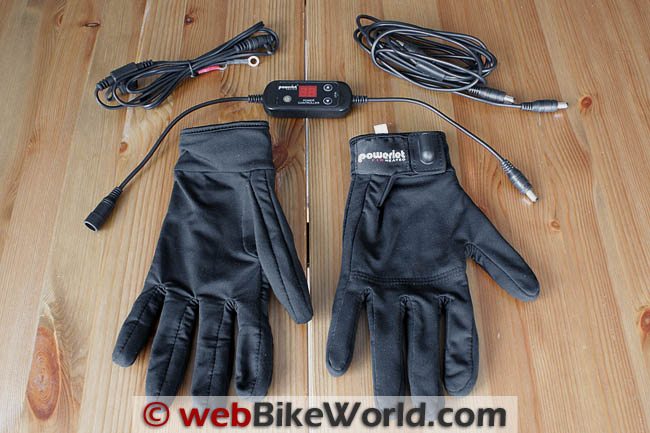
Powerlet rapidFIRe Heated Glove Liner Kit (PHG-411-L)
My last two pair of glove liners were size XL and XXL to get a decent fit, although neither of them have enough stretch to help offset typical finger and thumb length deficiencies, which is the hardest fitment issue that I typically deal with.
I wasn’t disappointed after getting and trying on the L/XL Powerlet glove liners.
The material used is thin and very elastic; the gloves truly fit and conform like a glove should.
My only observation is that the thumb, at least for me, needs another 5 or 6 mm of depth. This minor shortfall is essentially offset by the stretch factor of the gloves, so it isn’t a big issue, but possibly something that could be addressed.
And this brings up things that I notice a lot of consumers not doing when trying on gloves or inner liners… There is a real need to stretch the hand, lay it on a flat surface, then spread it out.
Next, make a fist and actually sit on a motorcycle gripping the handlebars. Many dealers now provide “test grips” for just this purpose, which can also serve to demonstrate the warmth provided by heated grips.
Gloves, inner and outer, are an important part of any rider’s personal safety equipment. A big part of being safe is being comfortable and not wearing equipment that detracts rather than enhances…’nuff said.
The rapidFIRe glove liner kit comes with the selected size of gloves (identified as part of the part number on the website); a five-position digital controller; one battery connection lead; and one Y-harness to connect everything together.
A nifty Powerlet lanyard rounds out the kit. Fingers are box-end design and appear unevenly cut, at least until worn.
Each liner is rated at 14 Watts or 28 Watts per pair. The electrical interface is a small plastic housing with a 2.5 mm coax connector and the housing is stitched to the top of each wrist adjustment tab.
When the gloves are pulled on the hands, any notion about problems with the cut cut disappears.
Extremely comfortable and tight fitting, the glove liners can be left on to do just about anything typically required when getting ready to head off or during stops — even typing with them on is no problem!
What makes them so darn comfortable, other than their elasticity, is the absence of any discernible harness or constrictive wire runs — you truly do not feel any wires or even the heat pads although with very close inspection some very small flat pad patterns can be discerned.
The use of these broad surface and encompassing heat pads is what makes the RapidFIRe glove liners, like the jacket liner as well, so effective.
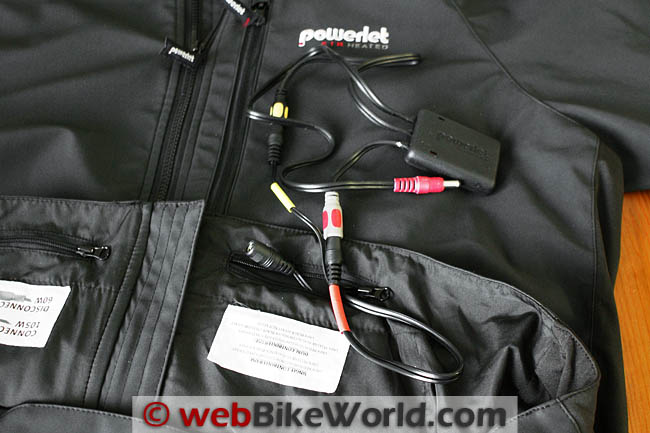
Initializing the Powerlet Dual Wireless Temperature Controller
As a bundled package (PN PHG-901) the Powerlet RapidFIRe ProForm Jacket Liner and Dual Wireless Temperature Controller provides everything needed for almost any type of installation, as does the RapidFIRe Glove Liner kit.
One of the kits listed on the website include a standard Powerlet/BMW plug for those that want or need to utilize this type of power source.
Having installed one of the supplied battery connection harnesses to the F800GS and the R1200RT, I can power the jacket liner and glove liners separately or together, directly from the battery, the coax power outlets controlled by the Dispatch 1 (review) or by using one of my Powerlet/BMW power plugs.
So now the next important step — getting the receiver and the wireless remote talking to each other.
Unless the components have already been paired (unlikely if new), don’t forget to complete this procedure or you may be scratching your head and wondering why nothing works.
The following steps outline the ‘pairing’ procedure:
- Leave the receiver module unplugged from power.
- Using one rotary, turn the remote On and Off quickly three (3) times or six clicks allowing the LED to activate between each click; end in the Off position.
- As initiated, the LED on the Remote will start double-blinking, for ten seconds only.
- While double-blinking is active, connect the receiver module to power (quickly).
- The units will now pair up automatically, and it should not have to be done again, and
- Activating the Red or jacket rotary should result in heat being felt.
Once this is done, use of the system is pretty much like any other single or dual controller. On the dual controller, the Red rotary is for the jacket liner and the Yellow for the secondary circuit such as the gloves via their outlets on each sleeve.
If the remote doesn’t work with the receiver module, check the power source connection.
When the jacket receiver module is initially connected to power as outlined above, the Red LED should turn on briefly (flash), while the Yellow LED will not. Note: if polarity is reversed or there is a fault, the Yellow will light up.
When either rotary control is moved the respective LED will activate briefly (a second or less), indicating the change has been transmitted to the receiver module in the garment.
The radio technology used, which I suspect is a ZigBee radio implementation, requires little power and is very efficient.
Subsequently, the battery in the remote control should last a full season.
When it does need to be changed, remove the small screws holding the back on and insert a new CR2032 (or equivalent) cell. Synchronization should not be required after the battery is changed.
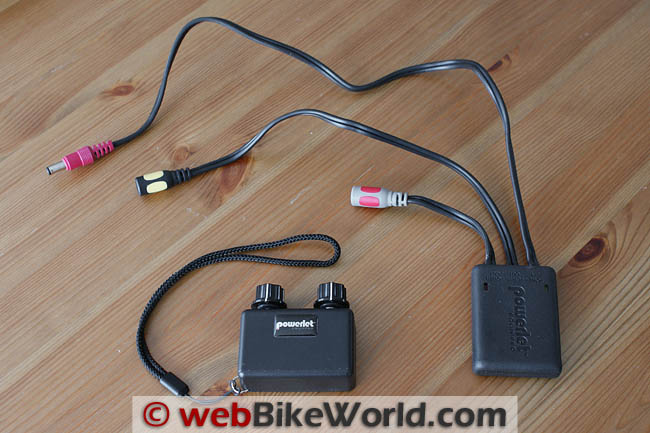
Powerlet RapidFIRe Garment Configurations
As both the controller and jacket liner configurations can be changed, the respective options are briefly described in the following paragraphs.
The jacket liner has three leads and the small receiver interface module has three, sounds simple. Everything is colour-coded, which is good.
The three colour-coded leads on the receiver module are each a different length (another coding) and their function clearly marked on the face of the module.
The longest lead is the Red power input plug while the middle-length Black/Yellow and the shortest Grey/Black coax socket connectors are outputs.
So to match things up with the jacket leads: the Gray/Red socket goes to the Red label liner plug and the Black/Yellow socket mates up to the Yellow label liner plug.
The Black socket liner lead is not used for dual controller configuration, but it is used when configuring the jacket liner for use with a single heat controller. In this instance, the Black socket liner lead is connected to the liner’s Yellow plug. Only the Red plug from the liner is used, with the Gray/Red connection on the receiver module.
To change from the full output potential of 105 Watts to the 60 Watt setting (full heat coverage is retained) the single White label lead hidden in the right front lower pouch is disconnected. When full power is desired again, just reconnect it.
If the Remote is “misplaced” (i.e., lost), powering up the dual circuit receiver will result in only one-third power being available until such time as the Remote is found and activated — an intentional safety feature.
On the other hand, the single circuit receiver has a button with five levels so the system can be used fully even if the remote is lost or unavailable.
Does It All Work?
I’ve always been impressed at the speed with which newer heated clothing products come up to temperature, especially the Gerbings microwire garments (reviews). But the Powerlet RapidFIRe garments are faster — much faster.
I can activate the Red (jacket) rotary to about 30% and before I can snap the SCHUBERTH C3 (review)closed and let out the clutch, the warm, creeping, soothing heat can be felt. It takes only a matter of seconds.
The rapidFIRe jacket liner fits perfectly and I have been wearing it continually for two weeks now. Outside of finding the small main zipper somewhat finicky to engage, there hasn’t been anything else to nitpick about.
While the interconnect wiring bundle makes its presence felt, it is unobtrusive and conforms when I am sitting on the motorcycle and as such, is far more forgiving than a hard plastic stitched-in-place power distribution unit.
With my BMW Rallye Pro 3 jacket (a 2 to 2.5 season jacket) and with ambient air temperatures ranging from 25 F to 40 F plus generating a wind-chill at highway speeds, the heat settings of less than 30% allowed some wind chill to be felt.
I could also feel cold spots in the upper forearm, just below the shoulder and about mid-neck, but that was about it.
When the heat output is set to 40% or slightly higher, the “weak” spots are still slightly noticeable but as the heat radiation becomes more pronounced, these spots seem to disappear, due more to overall tissue warming than anything.
The minor deficiency areas are most pronounced when on a motorcycle with minimal frontal coverage.
In another example, even though my MSR Gore-Tex double-lined jacket is more of an overcoat when paired with the rapidFIRE jacket liner, the effectiveness of this combination serves to remind me why I think the MSR jacket is one of the best rain and wind blocking garments ever.
With this combination, even in sub-zero air temperatures with significant wind-chill generated from 100-120 kmh speeds on either the F800GS or the R1200RT, I was absolutely toasty with the jacket heat setting at 35-50%, never anything higher.
On two occasions, I cranked the jacket rotary up to full and less than two minutes later I was turning the dial back down to where it had been. I mistakenly did this once with the gloves as well…lesson learned!
The rapidFIRe glove liners are even more effective than the jacket liner, whether they are connected to the jacket leads and powered from the second circuit or functioning on their own via the LED equipped digital controller.
The combination of my Gore-Tex shell over-gloves and the rapidFIRe glove liners proved to be just what I have been looking for.
The Gore-Tex gloves have housed other insulated inner gloves and heated glove liners, but the warmest and most comfortable combination by far is with the rapidFire glove liners inside.
At no time — with or without hand-guards and without hand warmers — did I ever need to use more than 40% on the dual controller secondary circuit and only the 2nd or 3rd setting of five on the single in-line controller.
Even two blasts down the 416 on the BMW HP2 Sport didn’t change how my hands felt.
The Powerlet glove liners cover my digits and back surfaces in soothing encompassing heat. I never had cold spots and best of all circulation was much improved — no cramping at any time. Comfort and safety — it bears repeating.
Under most riding conditions and a wide range of temperatures, both the jacket liner and the glove liners are more than capable of generating excessive heat that would likely get uncomfortable in all but the coldest settings. Heed the warnings tendered — this is why controllers exist!
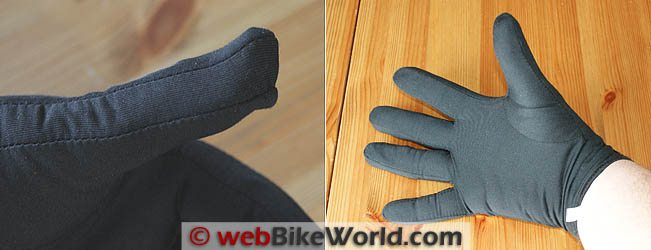
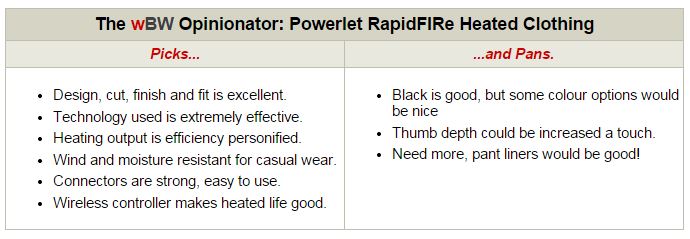
Conclusion
As of the publication date, we still do not have a lot of marketing material or technical information from Powerlet regarding this new product line, especially the technology used which by itself is intriguing.
So while I cannot verify the technology used, I can verify that it works. I have never worn anything that works as fast and as well as the rapidFIRe heated clothing products.
Cut and fit of the garments is first-rate, less my minor thumb observation. Although the components evaluated may be early samples, from the standpoint of design, cut, fit and function, my perspective is that they are first-rate.
More wBW: Heated Clothing Reviews | Motorcycle Glove Reviews
Owner Comments and Feedback
See details on submitting comments.
From “E.C.” (November 2013): “I’ve been searching the internet for a glove to use with my rapidFIRe glove liners. I just want something to protect my hands and keep them dry as the liners keep them warm. You refer to your “Gore-Tex shell over-gloves” as outlined in (the review). Could you recommend a pair of “shell” gloves to use with the rapidFIRe liners?
H.B.C.’s Reply: The “Gore-Tex shell over-glove” mentioned in the article are a well-used and treasured pair of Olympia Gore-Tex outer gloves in XL (sized larger for outer glove use), marketed as the Olympia 4298 Gore-Tex 2-in-1 Commander Gloves).
The Gore-Tex and lightweight insulation layers allow them to be used alone or with an inner glove. For sustained wet or cold weather riding, they are the best outer glove I have ever used.
For cold weather riding a natural, synthetic or combination inner glove provides warmth while still trapping air between the layers — key to a warm combination. When temperatures are near or below 0C (32F), especially with any added wind chill factor, the rapidFIRe electrically heated liners and the Gore-Tex outer glove is an unbeatable combination, while still allowing good flexibility of the hands/fingers.
These gloves, or a similar product from another brand would be effective as well, although the Gore-Tex advantage is hard to beat.
From “P” (October 2011): “I have read your review on the Powerlet Jacket Liner and I’d like to ask if you personally experienced any heat in the collar? I have just received my new jacket liner and on both settings I don’t detect any heat in the collar, maybe there isn’t any? But I understood it was a heated collar.
I’d be interested to hear back from you on this one, I will approach Powerlet but maybe the amount is insignificant and I just don’t detect it.
HBC’s Reply: The Jacket Liner reviewed sees continual use, especially as we head towards winter. The jacket liner has one or possibly two very thin heating pads in the collar (hard to discern but they are there) and when the collar is down fully up against my neck, I can feel the heat, more so on a 20 to 30 percent and higher setting.
It is not as concentrated as felt on other parts of the torso and sleeves, but it is there. If you are not getting any heat at any setting through the collar, then there may indeed be something wrong.
I can state that if you wear a medium or heavy turtleneck or neck-warmer underneath, then detecting output from the collar will be more difficult. While I wear a long-sleeved T-shirt or very light fleece underneath the jacket liner, the collar portion of the jacket liner is typically zipped up directly against my neck, so I do get direct benefit of the radiated heat. My neck-warmer is worn over the collar, next to the outer garment.”
From “D.W.” (04/11): “Can you find out if the glove liners “wrap” your fingers and hands with warming areas or is it just the tops of the hands and fingers? I find that if the fingers are not “wrapped” in active heated materials, then your hands get cold as you grip the bars. Thanks and it was a good review.”
HBC’s Reply: Good question, but as more or less noted in the article, the glove liners do “wrap” the fingers, thumb and backs of hands in radiating heat other than just wherever a traditional filament would run. I haven’t yet noted any weak or ‘cold’ spots with the gloves, especially when gripping the bars.
The gloves, at least for my hands, have been just about perfect in terms of enveloping them in heat and helping circulation.
The constant tight grip on the handgrips can sometimes cause cold hands, as it severely impacts circulation, which is why it necessary or good to exercise the fingers and even the hand to a safe degree now and then, whether using heated glove liners, gloves or just external hand warmers of some type. But in many ways, the type of radiating warmth provided by heated gloves can help overcome the problems typically encountered.
Without tearing a glove apart (yet), the thin wire or conductor seems to run down the side of the digit but I suspect the “pad” wraps to a degree, which is part of the overall radiation and coverage approach. Glad to hear you enjoyed the review.”
From “H.W.” (04/11): “Point of interest… I believe the manufacturer of the wireless controller is Warm N Safe. I have one of their controllers (it’s so new, it doesn’t even have a manufacturer’s label on it!) and have had it since October of 2009 (I think).
I happen to know the owner (Mike Coan) of Warm N Safe, from the GTS mailing list many years ago, when I had one of those great bikes…
The only thing I would add is that it’s important to turn the controller OFF when it is not in use, otherwise it will use up the battery. Even if the battery goes get used up, the controller will allow some percentage of electricity to enter the garment for at least minimal heating. I actually carry a spare battery and a small screw driver on the bike, just in case.
Also, since my controller is perched atop my clutch reservoir, it is secured to the handle bar, by some fish line, acting as a safety harness. I almost lost it on a trip. Had it not been for the fish line harness it would’ve gone by-by, and I would’ve been one cold rider!”


